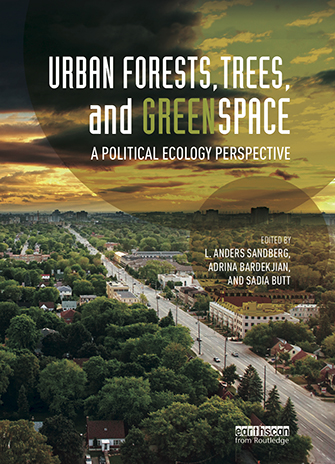Urban forests, trees and green space are critical in contemporary planning and development of the city, says York Professor L. Anders Sandberg. His new book, Urban Forests, Trees, and Greenspace, looks at those issues in a wide variety of places globally, among them the greening of city plazas in Honduras, the change in urban green governance in Singapore, the protests over tree cutting in Instanbul’s Gezi Park and the massive tree planting program in New York City.
 Urban Forests, Trees, and Greenspace: A Political Ecology Perspective, published by Routledge, is co-edited by Sandberg of the Faculty of Environmental Studies (FES) and FES and University of Toronto PhD students Adrina Bardekjian and Sadia Butt.
Urban Forests, Trees, and Greenspace: A Political Ecology Perspective, published by Routledge, is co-edited by Sandberg of the Faculty of Environmental Studies (FES) and FES and University of Toronto PhD students Adrina Bardekjian and Sadia Butt.
Alan Mabin, research Fellow, Capital Cities project, University of Pretoria, South Africa, calls it a “collection that makes urban political ecology accessible to a wide readership without losing the sophistication needed to handle the complexity and contradictions of the field. Its compelling narratives stretch from unruly trees and people in diverse cities around the world, to original ways of thinking about nature and the city.”
The editors’ research is not only a question of the growth and conservation of green spaces, but incorporates social, cultural and psychological dimensions. The book brings a perspective of political ecology to the complexities of urban trees and forests through three themes: human agency in urban forests and green space; arboreal and greens pace agency in the urban landscape; and actions and interventions in the urban forest.

“This book is the first to use the lens of political ecology to understand urban forests and finally provide us with a much needed politicized view of these spaces, based on case studies from around the globe,” writes Guy Baeten of Lund University, Sweden.
Contributors include leading authorities from North America and Europe from a range of disciplines, including forestry, ecology, geography, landscape design, municipal planning, environmental policy and environmental history.
“This wonderful volume incorporates new theoretical ground in the field of political ecology. Diverse chapters bring nuanced and balanced attention to the social and ecological dynamism that shapes the myriad ways through which urban forests constitute and are constituted by everyday lived experiences, politics, and institutional dynamics of today’s cities,” says Patrick Hurley of Ursinus College, Collegeville, in the United States.
The book’s beginnings are rooted in an idea that blossomed into an April conference last year on Urban Forests and Political Ecologies: Celebrating Transdisciplinarity at the University of Toronto.
“The conference was a huge success where academics, professionals, environmentalists and artists mingled to present and discuss their work on urban forests, trees and green space,” says Sandberg.
Sponsors from York University included the Faculty of Environmental Studies; the Vice-President Academic and Provost Rhonda Lenton; Vice-President Research and Innovation Robert Haché; Associate Vice-President Research Lisa Phillips, Canada Research Chair in Sustainability and Culture; the CITY Institute; York University Libraries; and Osgoode Hall Law School.
Other recent publications from environmental studies faculty members:

FES Professor Jin Haritaworn is the co-editor of the new book Queer Necropolitics (Routledge, 2014). This book comes at a time when the intrinsic and self-evident value of queer rights and protections, from gay marriage to hate crimes, is increasingly put in question.
 It assembles writings that explore the new queer vitalities within their wider context of structural violence and neglect. Moving between diverse geopolitical contexts – the US and the UK, Guatemala and Palestine, the Philippines, Iran and Israel – the chapters in this volume interrogate claims to queerness in the face(s) of death, both spectacular and every day.
It assembles writings that explore the new queer vitalities within their wider context of structural violence and neglect. Moving between diverse geopolitical contexts – the US and the UK, Guatemala and Palestine, the Philippines, Iran and Israel – the chapters in this volume interrogate claims to queerness in the face(s) of death, both spectacular and every day.

FES Professor Rod MacRae is co-editor of Managing Energy, Nutrients, and Pests in Organic Field Crops (CRC Press, 2014), which discusses the application of organic management practices in field cropping. The methods continue to rise globally and have proven to be a viable way to produce food with reduced resource use and environmental damage.
 The book challenges the popular misconception that organic systems are weak at managing energy, nutrients and pests and shows how innovative farm designs can enhance organic performance. It provides information for assessing the current state of knowledge on organic field cropping and for making the systems more viable.
The book challenges the popular misconception that organic systems are weak at managing energy, nutrients and pests and shows how innovative farm designs can enhance organic performance. It provides information for assessing the current state of knowledge on organic field cropping and for making the systems more viable.


